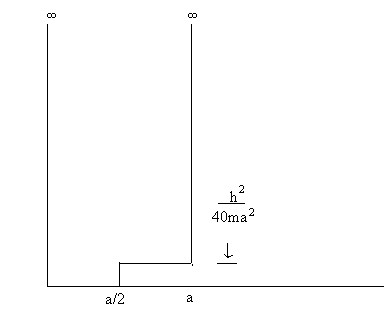

Stationary perturbation theory is concerned with finding the changes in the discrete energy levels and the changes in the corresponding energy eigenfunctions of a system, when the Hamiltonian of a system is changed by a small amount. Let H=H0+H’=H0+lW. H0 is the unperturbed Hamiltonian whose eigenvalues E0p and eigenstates |fip> are known. Let {|fip>}denote an orthonormal eigenbasis of H0, H0|fip>= E0p|fip>. Here i denotes the degeneracy. Assume that the matrix elements of H’ in the eigenbasis of H0 are small compared to the matrix elements of H0.
<fip|H'|fip> << <fip|H0|fip>=E0p.
We write H’=lW with l<<1 and <fip|W|fip>»E0p.
![]()
H=H0+H’ is the Hamiltonian of a perturbed one-dimensional harmonic oscillator.
We are looking for the eigenvalues E(l) and the eigenstates |y(l)> of H(l)=H0+lW.
H(l)|yp>=Ep(l)|yp> or, keeping the dependence on l in mind without specifically writing it down, H|yp>=Ep|yp>.
Since lW is small, we assume that E and |y> can be expanded as a power series in l.
Ep=E0p+lE1p+l2E2p+... ,
|yp>=|yp0>+l|yp1>+l2|yp2>+...
.
We may then write
(H0+lW)(|yp0>+l|yp1>+l2|yp2>+...)
= (E0p+lE1p+l2E2p+...)(|yp0>+l|yp1>+l2|yp2>+...).
This equation is must be valid over a continuous range of l. Therefore we equate coefficients of equal powers of l on both sides to obtain a series of equations that represent successively higher orders of the perturbation.
(H0-E0p)|yp0>=0 implies that |yp0> is a linear combination of unperturbed eigenfuctionns |fip> with the corresponding eigenvalue E0. We choose <yp0|yp0>=1. |yps> is not uniquely defined. We can add an arbitrary multiple of |yp0> to each |yps> without affecting the left hand side of the above equations. Most often this multiple is chosen so that <yp0|yps>=0. The perturbed ket is then not normalized.
We then have
![]()
0
=
![]()
![]()
To calculate the energy to sth order, we only need to know the state vector to order s-1.
Consider a particular non-degenerate eigenvalue E0n of H0. H0|fn>=E0n|fn>. The other eigenvalues of H may or may not be degenerate. We have |yn0>=|fn> and E1n=<fn|W|fn>.
The first-order energy correction therefore is lE1n=<fn|H’|fn>.
We have En=E0n+<fn|H’|fn>+O(l2).
![]()
![]()
![]()
En=E0n +O(l2). To first order, the eigenvalues of H are equal to the eigenvalues of the unperturbed Hamiltonian H0.
First-order eigenvector corrections
:(H0-E0p)|yp1> =( E1p-W)|yp0> = (E1p-W)|fp>. |yp0> is an eigenstate of the unperturbed Hamiltonian. We may expand
![]()
in terms of the basis vectors |fip'>. In the expansion bp=0 because <yp0|ypi>=0.
![]()
Multiply from the left by <fip''|.
![]()
![]()
Therefore
![]()
![]()
![]()
![]()
![]()
Second-order energy corrections
:Since we have found the expression for the state vector to first order, we can now find the expression for the energy to second order.
![]()
![]()
![]()
![]()
![]()
![]()
![]()
![]()
Let H=H0+H’=H0+lW. In practice, after having derived the perturbation expansion, we often set l=1 and let H’=W be small.
Problems: Calculate the first-order shift in the ground state of the hydrogen atom caused by the finite size of the proton. Assume the proton is a uniformly charged sphere of radius r = 10-13cm. The ground state wave function of the hydrogen atom isInside the sphere the potential
energy is ![]()
From Gauss’ law we know that ![]() (SI units).
(SI units).
![]()
![]()
Let
![]()
![]()
![]()
since r0 << a0,
![]()
![]()
=4´10-9eV.
(a) Calculate the first-order energy shift of the nth eigenvalue due to the perturbation.
(b) Write out the first three non vanishing terms for the first-order perturbation expansion of the ground state in terms of the unperturbed eigenfunctions of the infinite well.
(c) Calculate the second-order energy shift for the ground state.

H =H0+H’.
![]()
The eigenvalues of H0 are not degenerate.
![]()
![]()
![]()
![]()
![]()
![]()
![]() if n is odd.
if n is odd.
![]()
![]()


![]() second-order energy shift for the ground
state.
second-order energy shift for the ground
state.
The second-order energy shift of the ground state is always negative.